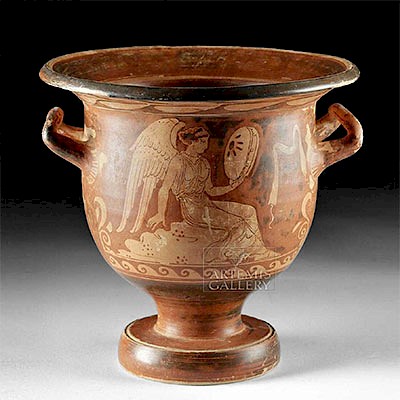Greek Archaic Terracotta Kore & Animal, ex-Bonhams
Lot 21
About Seller
Artemis Fine Arts
686 S Taylor Ave, Ste 106
Louisville, CO 80027
United States
Selling antiquities, ancient and ethnographic art online since 1993, Artemis Gallery specializes in Classical Antiquities (Egyptian, Greek, Roman, Near Eastern), Asian, Pre-Columbian, African / Tribal / Oceanographic art. Our extensive inventory includes pottery, stone, metal, wood, glass and textil...Read more
Estimate:
$800 - $1,600
Absentee vs Live bid
Two ways to bid:
- Leave a max absentee bid and the platform will bid on your behalf up to your maximum bid during the live auction.
- Bid live during the auction and your bids will be submitted real-time to the auctioneer.
Bid Increments
| Price | Bid Increment |
|---|---|
| $0 | $25 |
| $300 | $50 |
| $1,000 | $100 |
| $2,000 | $250 |
| $5,000 | $500 |
| $10,000 | $1,000 |
| $20,000 | $2,500 |
| $50,000 | $5,000 |
| $100,000 | $10,000 |
| $200,000 | $20,000 |
About Auction
By Artemis Fine Arts
Mar 7, 2019
Set Reminder
2019-03-07 10:00:00
2019-03-07 10:00:00
America/New_York
Bidsquare
Bidsquare : VARIETY SALE | Antiquities & Ethnographic Art
https://www.bidsquare.com/auctions/artemis-gallery/variety-sale-antiquities-ethnographic-art-3928
Around the world & back in time - be amazed at the treasures you will find. Antiquities from Egypt, Greece, Italy and the Near East, Asian, Pre-Columbian, African / Tribal / Oceanic, Native American, Spanish Colonial, Russian Icons, Fine Art, much more! Artemis Fine Arts info@artemisgallery.com
Around the world & back in time - be amazed at the treasures you will find. Antiquities from Egypt, Greece, Italy and the Near East, Asian, Pre-Columbian, African / Tribal / Oceanic, Native American, Spanish Colonial, Russian Icons, Fine Art, much more! Artemis Fine Arts info@artemisgallery.com
- Lot Description
Ancient Greece, Archaic period, ca. 600 BCE. A hollow, mold-formed terracotta female kore, standing barefoot atop an integral rectangular plinth and wearing a flowing garment. Against her chest she holds a small quadruped animal with a sinuous tail, though the exact species is difficult to discern. Her visage exhibits almond-shaped eyes, a prominent nose, slender cheeks, and an Archaic smile, all framed by braided bangs set against her brow. A large but simple headdress drapes across the backs of both shoulders. The verso displays an ovoid hole utilized during the firing process. This figure may have been painted with vibrant pigments, indicated by dark pigment remains underneath the neck. Kore were a common sight in both private and public life. Size: 2" W x 8.625" H (5.1 cm x 21.9 cm).
By the seventh century BCE, Greek art began to evolve from its embrace of the geometric style, which was favored between approximately 1050 and 700 BCE, to a desire to create more naturalistic representations of the human figure. Most famous are the freestanding sculptures of two main types, the male standing youth known as a kouros, and the draped standing female kore. The earliest examples demonstrate an Egyptian influence in both pose and proportions, but over time sculptors created even more lifelike representations. These were placed in sanctuaries as well as cemeteries and served as grave markers and dedications to the deities.
Provenance: private Houston, Texas, USA collection; ex-Bonhams London Antiquities Auction, 8 May, 2013, part of lot 52; ex-private London, United Kingdom collection, acquired by the present owner in London and the Home Counties between 1960s and 1980
All items legal to buy/sell under U.S. Statute covering cultural patrimony Code 2600, CHAPTER 14, and are guaranteed to be as described or your money back.
A Certificate of Authenticity will accompany all winning bids.
We ship worldwide and handle all shipping in-house for your convenience.
#132837Head reattached at neck line with light adhesive residue and some new material along break line. Restoration to portion of right shoulder. Surface wear commensurate with age, small nicks to base, body, and head, with fading to some facial features, and light discoloration, otherwise very good. Nice pigmentation remains in some areas, and light earthen deposits throughout.Condition
- Shipping Info
-
All shipping is handled in-house for your convenience. Your invoice from Artemis Gallery will include shipping calculation instructions. If in doubt, please inquire BEFORE bidding for estimated shipping costs for individual items.
-
- Buyer's Premium



 EUR
EUR CAD
CAD AUD
AUD GBP
GBP MXN
MXN HKD
HKD CNY
CNY MYR
MYR SEK
SEK SGD
SGD CHF
CHF THB
THB
















